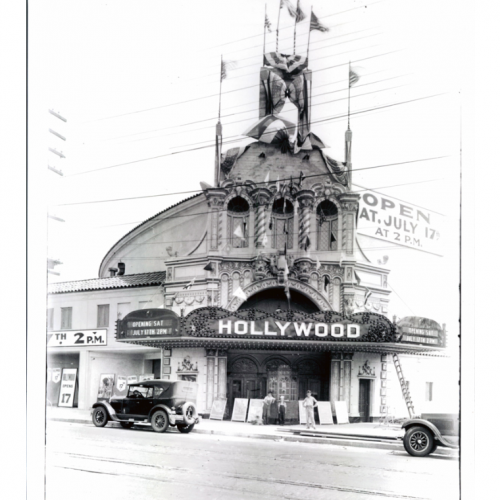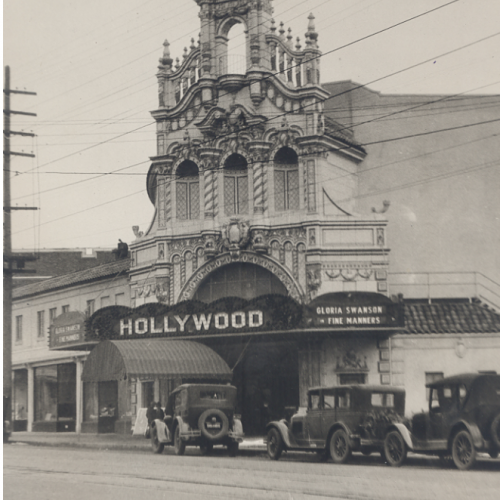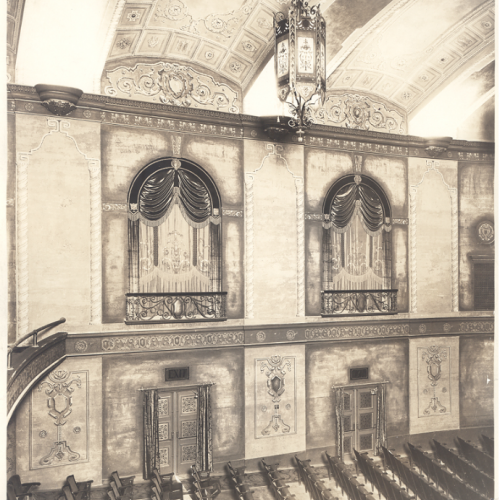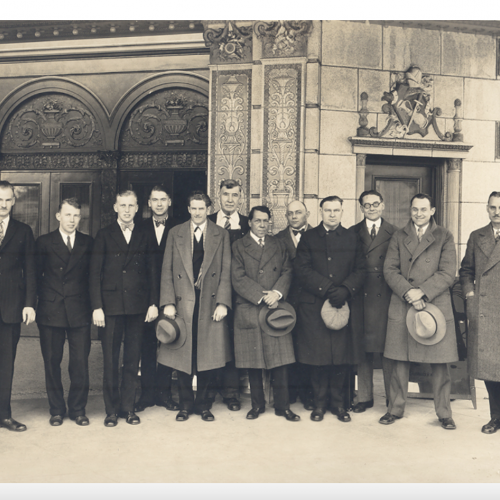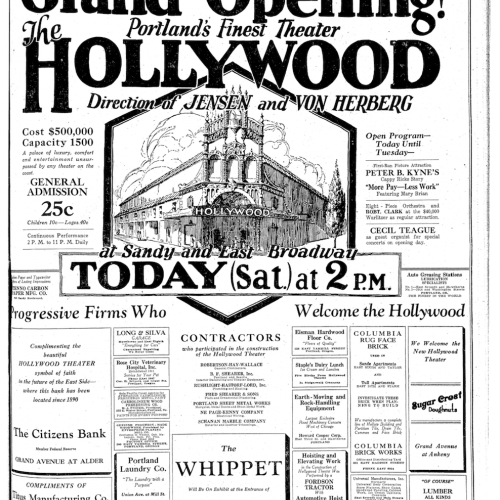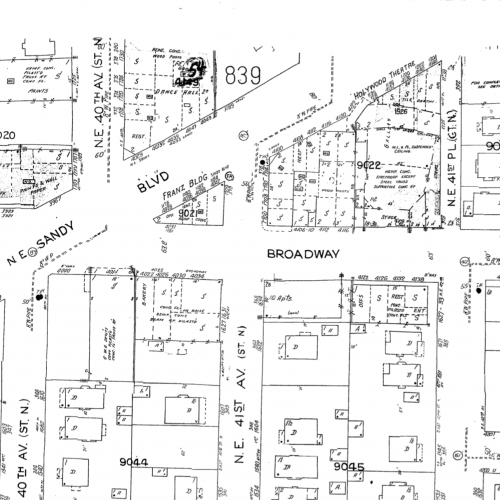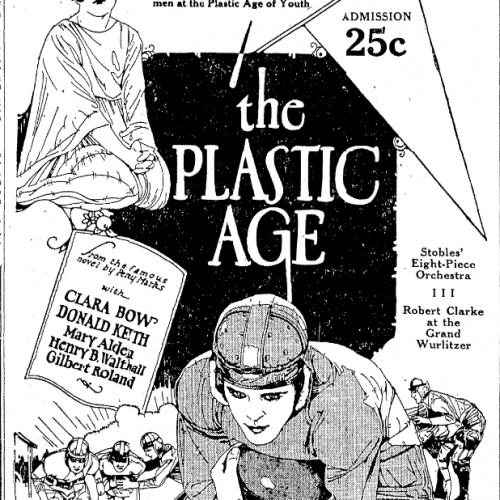The Hollywood Theater was built in 1926 by the very successful Claude Jensen and John von Herberg.1 The duo hired Bennes & Herzog, architects from Portland, and they spent $500,000 (a fortune at the time) to build the luxurious, beautiful theater, the exterior of which is in a Spanish-Colonial style and the interior of which is modeled after the Roman baths of Caracalla and the famous basilica of St Pietro. This magnificent theater instantly transported every viewer that walked into it and carried them into magical Spain and Italy. The theater is filled with beautiful colors and architecture. In fact The Hollywood Theater was considered so grand and beautiful that in 1983 it was registered on the National Register of Historical Places. The Hollywood is one of only three movie houses in Portland that are on the National Register.2 Not only was The Hollywood Theater extremely beautiful, but it also played notorious new films that audiences were excited to see. For example, on opening night the first film being shown was More Pay, Less Work, a short, silent film written by Peter Kyne.3 The Hollywood’s showing was the film’s world premier, and audience members flocked to the theater in excitement. A subsequent film shown in August was another silent film entitled The Plastic Age, a college story about the process of moulding boys into men and featuring Clare Bow and Donald Keith.4 While The Hollywood Theater showed mostly silent films, they also featured vaudeville acts and hired a variety of other acts to come and perform. One such performer was Gene Dennis, who was booked at The Hollywood for a week and who the Hollywood Theater promised would “mystify audiences all over America”.5 Gene Dennis was one of the most famous people of the 1920s and the best known psychic-performer in America at that time. The Hollywood Theater being able to book the then-famous Ms. Dennis evinces the reputation and popularity of the theater during that time. The Hollywood Theater was so renowned and popular that the entire surrounding neighborhood decided to change its name from the “Rosewood District” to the “Hollywood District.”6 Subsequently, however, The Hollywood Theater had to do a lot of difficult, creative marketing work to remain as popular as it was in the 1920s. The theater used a lot of modern promotional strategies to maintain and move up in the theater world. For example, The Hollywood had their name placed in various real estate ads7 in hope that the viewer would a) want to live in that vicinity because it was close to The Hollywood Theater, and b) would go to the theater because they lived near the theater. These real estate ads also had the benefit of introducing The Hollywood Theater to new and broader audiences who happened to be looking to buy or rent housing. In addition, The Hollywood Theater advertised when they were upgrading their technology to pull in people with their improved technology and audiovisual quality. In May of 1928, The Hollywood Theater advertised that “Movietone-Vitaphone programs will be offered,” making The Hollywood the only theater on the east side [of Portland] presenting this form of diversion.”8 With its beautiful architecture and design, its promotional strategies and its impressive programming, The Hollywood Theater started at the top of its game and was able to maintain its stature in subsequent years. After opening night, the Sunday Oregonian praised The Hollywood Theater, writing, “the daring colors—the wealth of decoration and appointments of the theater itself dominated the scene and inspired enthusiastic comments of admiration from everyone present.”9 Not only was The Hollywood Theater a magnificent, beautiful place filled with elegance and curiosity, but it also left a lasting impact on the neighborhood. To this day, locals and others still love The Hollywood Theater as much as they did at its opening in 1926.
While researching The Hollywood Theater, I found it much easier to find information than when I was researching The Ideal Theater. I think this is so because The Hollywood Theater is still open (and therefore of continued interest), while The Ideal Theater is long-closed. Also The Hollywood Theater was much more grand and therefore popular when it first opened than when The Ideal opened. So The Hollywood Theater received a lot more press and more articles were written about it. To research The Hollywood I primarily used Newsbank.com and found articles about the theater’s Grand Opening, the programming at the theater, updates about the theater, and reviews of the experience at The Hollywood. I also used sources from the Oregon Historical Society, which is where I found a lot of my pictures of The Hollywood Theater. Then a couple of days ago, when I thought I was done with my research, my friend Emily from class texted me a link and said “Idk if you found this yet but here ya go.” I opened the link and it was a National Register of Historic Places Registration Form for the Frances Building and Echo Theater. At first I was confused but then I kept reading and realized a couple pages down the form was comparing The Echo with The Hollywood because The Hollywood is one of three theaters on the National Register. Once I realized it was on the National Register, I went to the National Archives catalog and found The Hollywood’s National Register of Historic Places Nomination Form from 1983. This find gave a lot of useful and descriptive information about The Hollywood that I was able to use in my write-up. I was also able to find the Sanborn Fire Map, but it took a lot of digging and patience, to help locate the Hollywood Theater. When I began this process I didn't know The Hollywood Theater’s original address (or if the address had changed at all). All I had to go off of was the supposed current address of the theater, which was the corner of NE Broadway and Sandy Blvd. in Northeast Portland. To determine the exact address, I started by looking for Sandy and Broadway in the indices and then I moved on to adjacent streets. I was having no luck until, once again, Emily saved the day and showed me a picture she had taken in the Special Collections section of the library (which i probably should have just gone to in the first place). It was a picture of addresses of theaters in 1927, and there was The Hollywood Theater with its address shown as Sandy Blvd. and 41st Street (not Broadway). Once I had the correct address it was easy to find The Hollywood Theater’s location on the Sanborn map. I also had a difficult time figuring out who the owners and managers were because I found the names of many different owners and managers. I wasn’t sure which reports were correct. Also it was difficult to figure out who owned The Hollywood Theater because in the 1920s they used strange words to describe these higher up positions like “direction of Jensen and Von Herberg” or “presided over.” Those terms are not very specific so I was not sure if those terms really meant “owner,” “manager,” “contractor,” or something else. Because of this I wasn't able to figure out exactly who built, managed and owned the theater. While I found that researching The Hollywood Theater was easier than others in most regards, some things gave me difficulty like the Sanborn map and past addresses of the theater, but I eventually found them with patience and persistence. And then this past Friday I made a sojourn to Portland, in part to locate and view The Hollywood Theater (I also visited the Bagdad Theater inside and out). The Hollywood Theater was as beautiful and majestic as I had read, and I understood why its allure had stood the test of time.
